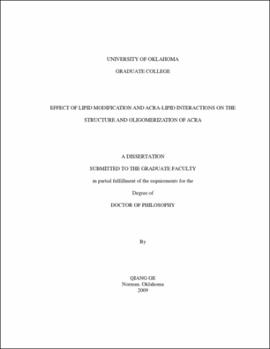| dc.contributor.advisor | Zgurskaya, Helen I | |
| dc.creator | Ge, Qiang | |
| dc.date.accessioned | 2019-04-27T21:41:01Z | |
| dc.date.available | 2019-04-27T21:41:01Z | |
| dc.date.issued | 2009 | |
| dc.identifier | 998540102042 | |
| dc.identifier.uri | https://hdl.handle.net/11244/319337 | |
| dc.description.abstract | A wide range of antibacterial agents including antibiotics can be expelled out of the cell by AcrAB-TolC complex. In this complex, the membrane fusion protein AcrA is located in the periplasm and essential for drug efflux. Although AcrA is generally considered to be a physical linker that strengthens the weak interaction between the RND type transporter AcrB and the outer membrane channel TolC, the molecular mechanism of AcrA is still not well understood. To elucidate how AcrA functions in the multidrug efflux complex AcrAB-TolC, we characterized the structure of AcrA. Using the in vitro limited proteolysis approach, we demonstrated that both the N-terminal lipid modification and E. coli polar lipids affect the accessibility of AcrA to trypsin. In addition, we found that the cleavage sites are located in the conserved membrane proximal (MP) domain of AcrA. We next used these sites as a map to characterize the structure of AcrA in the periplasm. Our in vivo study showed that the overall structure of over-expressed AcrA in vivo is similar to that of the purified AcrA. However, the trypsin cleavage of the chromosomally encoded AcrA demonstrated that the tripartite AcrAB-TolC assembly protects the MP domain of AcrA. This result thus suggests that the MP domain of AcrA is required for the functional assembly of the multidrug efflux complex AcrAB-TolC. | |
| dc.description.abstract | The oligomeric state of AcrA is still uncertain. Here we used formaldehyde cross-linking and size exclusion chromatography to study the oligomerization of AcrA. We found that, in contrast to the monomeric form of soluble AcrA (AcrAS-His), the lipidated AcrA (AcrAL-His) exists as an oligomer, mostly as a trimer. This result indicates that lipid modification promotes oligomerization of AcrA. In addition, soluble AcrA can form an oligomer in the presence of E. coli polar lipids and low concentrations (less than 100 mM) of sodium chloride, suggesting that AcrA-lipid interaction is one of the driving forces for the oligomerization of soluble AcrA. We concluded that AcrA functions as an oligomer, possibly a trimer. | |
| dc.format.extent | 119 pages | |
| dc.format.medium | application.pdf | |
| dc.language | en_US | |
| dc.relation.requires | Adobe Acrobat Reader | |
| dc.subject | Lipids--Metabolism | |
| dc.subject | Oligomers | |
| dc.subject | Polymerization | |
| dc.title | Effect of lipid modification and AcrA-lipid interactions on the structure and oligomerization of AcrA | |
| dc.type | text | |
| dc.type | document | |
| dc.thesis.degree | Ph.D. | |
| ou.group | College of Arts and Sciences::Department of Chemistry and Biochemistry | |
